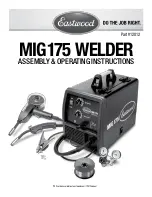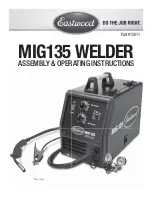
EN
EN
DANGER!
To prevent serious injury and death: If the operator is not holding the Torch, it
must be sitting on a nonconductive, nonflammable surface. The Stick Welder will
immediately turn on when the power button is turned on.
Stroke the workpiece lightly to ignite the arc. Do not strike like a match. Never tap
the electrode wire to ignite the arc; it will damage the electrode.
4. When the arc ignites, tilt the electrode forward and hold it near the workpiece.
5. If too much current is drawn from the welder; the Thermal Overload protector
will activate, the Warning indicator will light, and the CODE 804 will be showed on
the digital display, at the same time, the welder will turn off until it cools down. It
will automatically reset.
When finished welding
a. Release the Torch handle trigger and lift the Torch handle from the
workpiece,
b. Press the Power Switch to the Off (O) position.
c. Set the Torch handle down on the metal workbench,
d. Turn the air supply off, Unplug the line cord from the electrical outlet
86
Tungsten Inert Gas (TIG) Welding
Gas tungsten arc welding (GTAW), also known as tungsten inert gas (TIG) welding, is
an arc welding process that uses a nonconsumable tungsten electrode to produce the
weld. The weld area is protected from atmospheric contamination by a shielding gas
(usually an inert gas such as argon), and a filler metal is normally used, though some
welds, known as autogenously welds, do not require it. A constant-current welding
power supply produces energy which is conducted across the arc through a column
of highly ionized gas and metal vapors known as plasma. TAW is most commonly used
to weld thin sections of stainless steel and non-ferrous metals such as aluminum, ma-
gnesium, and copper alloys. The process grants the operator greater control over the
weld than competing procedures such as shielded metal arc welding and gas metal arc
welding, allowing for stronger, higher quality welds. However, GTAW is comparatively
more complex and difficult to master, and furthermore, it is significantly slower than
most other welding techniques. A related process, plasma arc welding, uses a slightly
different welding torch to create a more focused welding arc and as a result is often
automated.
87
Содержание ALPHA 225
Страница 72: ...PL 143...
Страница 73: ...PL PL 144 145...
Страница 74: ...PL PL 146 146 147...
Страница 75: ...PL PL 148 149...
Страница 76: ...PL PL 150 150 150 151 151 151...
Страница 77: ...PL PL 152 153...
Страница 78: ...PL PL 154 155...
Страница 79: ...PL PL 156 156 157 157...
Страница 80: ...PL PL 158 158 159 159...
Страница 81: ...PL PL 160 161...
Страница 82: ...PL PL 162 162 163 163...
Страница 83: ...PL PL 164 165...
Страница 84: ...PL PL 166 166 167 167...
Страница 85: ...168 168 168 169...
















































